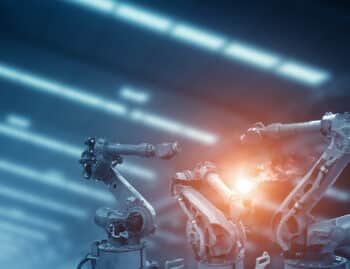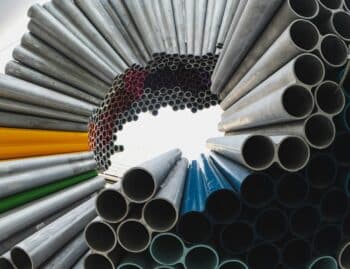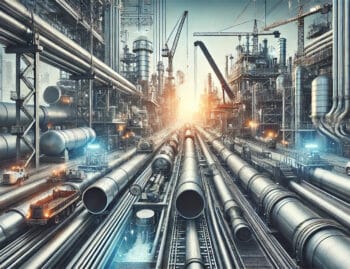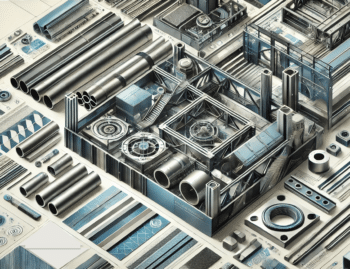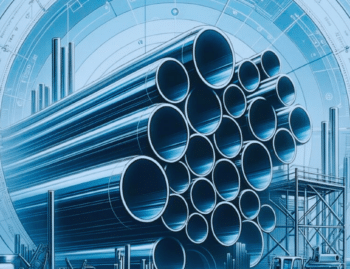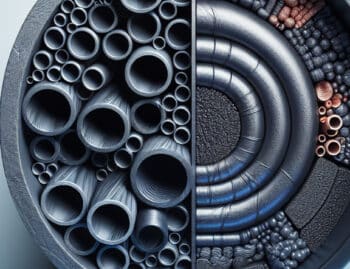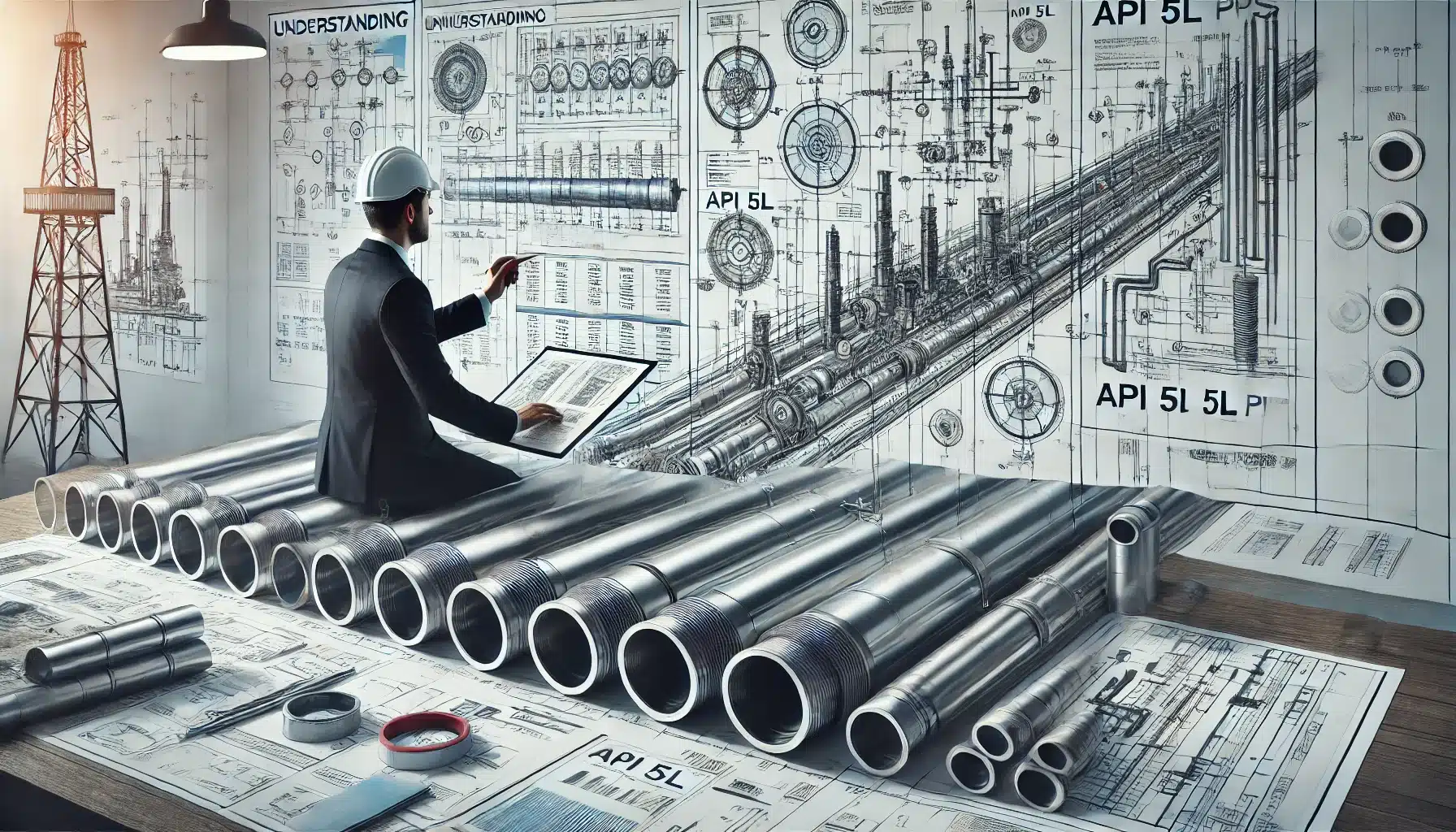
Introduction to API 5L Pipes
API 5L pipes are essential components in the oil & gas, construction, manufacturing, and power generation industries. This comprehensive guide delves into the specifications, grades, and applications of API 5L pipes, providing procurement managers, engineers, and project managers with the critical information needed to make informed decisions. From understanding the different grades and their mechanical properties to exploring the various applications and benefits, this article serves as a valuable resource for professionals seeking reliable, high-quality piping solutions.
Importance in the Oil & Gas Industry
API 5L pipes play a crucial role in the oil and gas industry. These pipes are designed to transport petroleum and natural gas over long distances, often through challenging environments. The robust construction and adherence to stringent standards ensure that these pipes can withstand high pressures, extreme temperatures, and corrosive substances. This reliability is vital for maintaining the integrity of pipelines and preventing leaks or failures that could lead to environmental disasters and significant financial losses.
Role in Construction and Manufacturing
In the construction and manufacturing sectors, API 5L pipes are used for various structural applications. Their high strength and durability make them ideal for supporting heavy loads and withstanding harsh conditions. Whether it’s for building frameworks, machinery, or infrastructure projects, these pipes provide the necessary support and stability. Additionally, their versatility allows them to be used in a wide range of applications, from residential buildings to large industrial complexes.
Applications in Power Generation
Power generation facilities rely on API 5L pipes for the transportation of steam, water, and other fluids. These pipes ensure the efficient and reliable operation of power plants, contributing to the generation of electricity. The high-quality materials and manufacturing processes used in API 5L pipes make them suitable for the demanding conditions found in power generation environments. This reliability helps to minimize downtime and maintenance costs, ensuring a steady supply of power.
Overview of API 5L Specifications
What is API 5L?
API 5L is a specification developed by the American Petroleum Institute (API) for seamless and welded steel pipes used in pipeline transportation systems in the petroleum and natural gas industries. This specification covers various grades of pipes, including B, X42, X52, X60, X65, and X70. Each grade has specific requirements for chemical composition, mechanical properties, and testing, ensuring that the pipes meet the necessary standards for their intended applications.
Historical Development of API 5L Standards
The API 5L standard has evolved over the years to meet the increasing demands of the industry. Initially developed to provide a consistent set of guidelines for pipeline construction, the standard has been updated to incorporate advancements in technology and materials. These updates have improved the performance and reliability of API 5L pipes, making them suitable for a wider range of applications and environments.
Key Features and Benefits
API 5L pipes offer several key features and benefits, including high strength, durability, and resistance to corrosion. These properties make them ideal for use in harsh environments and long-term applications. Additionally, the strict quality control measures and testing requirements ensure that the pipes meet the necessary standards for safety and performance. This reliability is crucial for maintaining the integrity of pipelines and preventing leaks or failures.
API 5L Product Levels
PSL1: Basic Quality Level
Chemical Composition
PSL1 pipes have a basic chemical composition that meets the minimum requirements for line pipe applications. This includes specific limits on elements such as carbon, manganese, phosphorus, sulfur, and silicon. These limits ensure that the pipes have the necessary strength and durability for standard pipeline applications.
Mechanical Properties
PSL1 pipes provide adequate mechanical properties for standard pipeline applications. This includes minimum requirements for yield strength, tensile strength, and elongation. These properties ensure that the pipes can withstand the pressures and stresses encountered during operation.
PSL2: Higher Quality Level
Enhanced Chemical Composition
PSL2 pipes have stricter chemical composition limits, ensuring higher quality and consistency in the material. This includes tighter controls on elements such as carbon, manganese, phosphorus, sulfur, and silicon. These stricter limits help to improve the overall performance and reliability of the pipes.
Stricter Mechanical Properties
PSL2 pipes offer superior mechanical properties, including higher yield and tensile strength. These properties make them suitable for more demanding applications, where higher pressures and stresses are encountered. Additionally, PSL2 pipes have stricter requirements for elongation, ensuring that they can withstand deformation without failing.
Additional Testing Requirements
PSL2 pipes undergo additional testing to ensure their performance in extreme conditions. This includes Charpy V-Notch (CVN) impact tests, which measure the pipe’s ability to absorb energy and resist fracture. These tests help to ensure that the pipes can withstand the harsh conditions encountered in many pipeline applications.
Pipe Manufacturing Processes
Seamless (SMLS) Pipes
Manufacturing Process
Seamless pipes are made from solid round billets, which are heated and then pierced to create a hollow tube. This process involves several steps, including heating the billet, piercing it with a mandrel, and then rolling and stretching it to the desired size and thickness. The result is a pipe with a smooth, continuous surface and no welded seams.
Advantages and Disadvantages
Seamless pipes offer several advantages, including high strength and uniformity. The absence of welded seams reduces the risk of defects and weaknesses, making these pipes suitable for high-pressure applications. However, seamless pipes are generally more expensive and limited in size compared to welded pipes. The manufacturing process is also more complex and requires specialized equipment.
Electric Resistance Welded (ERW) Pipes
Manufacturing Process
ERW pipes are made by welding the edges of steel coils, creating a continuous seam along the length of the pipe. This process involves several steps, including forming the steel coil into a cylindrical shape, welding the edges together using electric resistance, and then sizing and finishing the pipe to the desired dimensions. The result is a pipe with a strong, continuous weld seam.
Advantages and Disadvantages
ERW pipes are cost-effective and available in larger sizes compared to seamless pipes. The manufacturing process is relatively simple and efficient, making these pipes suitable for a wide range of applications. However, ERW pipes may have lower strength compared to seamless pipes, and the weld seam can be a potential weak point if not properly inspected and tested.
Double Submerged Arc Welded (DSAW) Pipes
Manufacturing Process
DSAW pipes are made by welding both inside and outside the seam, providing additional strength and durability. This process involves several steps, including forming the steel plate into a cylindrical shape, welding the edges together using submerged arc welding, and then welding the inside and outside seams. The result is a pipe with a strong, double-welded seam.
Advantages and Disadvantages
DSAW pipes offer high strength and are suitable for large-diameter applications. The double-welded seam provides additional strength and durability, making these pipes ideal for high-pressure and high-stress applications. However, DSAW pipes are more complex and costly to produce compared to ERW pipes. The manufacturing process requires specialized equipment and skilled operators.
Sizes and Dimensions of API 5L Pipes
Seamless Pipe Sizes
Seamless pipes are available in a wide range of sizes, from 2″ NPS to 36″ OD. This variety of sizes allows for flexibility in application, making seamless pipes suitable for a wide range of projects. The availability of different sizes ensures that the right pipe can be selected for the specific requirements of each project.
ERW Pipe Sizes
ERW pipes are available in sizes ranging from 2″ NPS to 24″ OD. This range of sizes provides options for various applications, from small-scale projects to larger industrial applications. The availability of different sizes ensures that the right pipe can be selected for the specific requirements of each project.
DSAW Pipe Sizes
DSAW pipes are available in sizes ranging from 20″ to 48″ OD. This range of sizes makes DSAW pipes ideal for large-scale projects and heavy-duty applications. The availability of different sizes ensures that the right pipe can be selected for the specific requirements of each project.
Delivery Conditions for API 5L Pipes
PSL1 Delivery Conditions
PSL1 pipes can be delivered in as-rolled, normalized, or normalizing formed conditions. These delivery conditions provide options based on the specific requirements of each project. The as-rolled condition is the most basic, while the normalized and normalizing formed conditions provide additional strength and durability.
PSL2 Delivery Conditions
PSL2 pipes must be delivered in a normalized condition. This ensures consistent quality and performance, making PSL2 pipes suitable for more demanding applications. The normalized condition provides additional strength and durability, ensuring that the pipes can withstand the pressures and stresses encountered during operation.
Chemical and Mechanical Properties
Chemical Composition of PSL1 Pipes
PSL1 pipes have a basic chemical composition that meets the minimum requirements for standard pipeline applications. This includes specific limits on elements such as carbon, manganese, phosphorus, sulfur, and silicon. These limits ensure that the pipes have the necessary strength and durability for standard pipeline applications.
Mechanical Properties of PSL1 Pipes
PSL1 pipes provide adequate mechanical properties, including yield and tensile strength, for reliable performance. These properties ensure that the pipes can withstand the pressures and stresses encountered during operation. The minimum requirements for yield strength, tensile strength, and elongation ensure that the pipes can perform reliably in standard pipeline applications.
Chemical Composition of PSL2 Pipes
PSL2 pipes have stricter chemical composition limits, ensuring higher quality and consistency in the material. This includes tighter controls on elements such as carbon, manganese, phosphorus, sulfur, and silicon. These stricter limits help to improve the overall performance and reliability of the pipes.
Mechanical Properties of PSL2 Pipes
PSL2 pipes offer superior mechanical properties, including higher yield and tensile strength. These properties make them suitable for more demanding applications, where higher pressures and stresses are encountered. Additionally, PSL2 pipes have stricter requirements for elongation, ensuring that they can withstand deformation without failing.
Testing Requirements for API 5L Pipes
Charpy V-Notch (CVN) Impact Test
The CVN impact test is required for many PSL2 pipe sizes and grades. This test measures the pipe’s ability to absorb energy and resist fracture, ensuring its performance in extreme conditions. The CVN impact test helps to ensure that the pipes can withstand the harsh conditions encountered in many pipeline applications.
Non-Destructive Testing (NDT)
Ultrasonic Testing
Ultrasonic testing is used to detect internal flaws and ensure the integrity of the pipes. This non-destructive testing method uses high-frequency sound waves to inspect the pipe’s internal structure, identifying any defects or inconsistencies. Ultrasonic testing helps to ensure that the pipes meet the necessary standards for safety and performance.
Radiographic Testing
Radiographic testing provides detailed images of the pipe’s internal structure, identifying any defects or inconsistencies. This non-destructive testing method uses X-rays or gamma rays to inspect the pipe’s internal structure, providing a clear image of any defects or inconsistencies. Radiographic testing helps to ensure that the pipes meet the necessary standards for safety and performance.
Hydrostatic Testing
Hydrostatic testing involves filling the pipe with water and applying pressure to ensure it can withstand the required operating conditions. This non-destructive testing method helps to ensure that the pipes can withstand the pressures and stresses encountered during operation. Hydrostatic testing helps to ensure that the pipes meet the necessary standards for safety and performance.
Applications of API 5L Pipes
Onshore and Offshore Pipelines
API 5L pipes are used in onshore and offshore pipelines for transporting oil, gas, and water. These pipes ensure safe and efficient transportation, maintaining the integrity of the pipeline and preventing leaks or failures. The high-quality materials and manufacturing processes used in API 5L pipes make them suitable for the demanding conditions encountered in onshore and offshore pipeline applications.
Sour Service Applications
Pipes used in environments containing hydrogen sulfide (H2S) must meet additional requirements specified in Annex H of API 5L. These requirements ensure that the pipes are resistant to corrosion and cracking, making them suitable for sour service applications. The high-quality materials and manufacturing processes used in API 5L pipes make them suitable for the demanding conditions encountered in sour service applications.
Offshore Service Applications
Pipes used in offshore environments must meet additional requirements specified in Annex J of API 5L. These requirements ensure that the pipes are durable and can withstand the harsh conditions encountered in offshore environments. The high-quality materials and manufacturing processes used in API 5L pipes make them suitable for the demanding conditions encountered in offshore service applications.
API 5L Grades and Their Significance
Understanding API 5L Grades
API 5L grades indicate the minimum yield strength of the pipe, with higher grades offering greater strength and performance. Each grade has specific requirements for chemical composition, mechanical properties, and testing, ensuring that the pipes meet the necessary standards for their intended applications.
Minimum Yield Strength
The minimum yield strength of API 5L pipes ranges from 42,000 psi for grade X42 to 70,000 psi for grade X70. This range of yield strengths provides options for various applications, from standard pipeline applications to more demanding environments. The availability of different grades ensures that the right pipe can be selected for the specific requirements of each project.
Common Grades: B, X42, X52, X60, X65, X70
Common API 5L grades include B, X42, X52, X60, X65, and X70. Each grade offers different levels of strength and performance, making them suitable for specific applications. The availability of different grades ensures that the right pipe can be selected for the specific requirements of each project.
Coating and Lining of API 5L Pipes
Importance of Coating and Lining
Coating and lining protect API 5L pipes from corrosion and improve flow efficiency, extending the lifespan of the pipes. These protective measures help to prevent the pipes from deteriorating over time, ensuring their long-term performance and reliability.
Types of Coatings and Linings
Various types of coatings and linings are available, including epoxy, polyethylene, and fusion-bonded epoxy. Each type offers different levels of protection and performance, making them suitable for specific applications. The availability of different coatings and linings ensures that the right protective measures can be selected for the specific requirements of each project.
Global Standards and Equivalents
International Recognition of API 5L
API 5L is recognized internationally and is equivalent to other standards such as ISO 3183. This international recognition ensures that API 5L pipes are accepted and used worldwide, providing a consistent set of guidelines for pipeline construction. For more information on global standards, you can refer to our ISO certification guide for steel pipes and tubes.
Equivalent Standards (ISO 3183, etc.)
Equivalent standards to API 5L include ISO 3183, which provides similar specifications and requirements for pipeline transportation systems. These equivalent standards ensure that API 5L pipes meet the necessary standards for safety and performance, regardless of the specific standard used. For a detailed comparison, you can check our ASTM standards guide for steel tubes and pipes.
Reference Documents and Further Reading
API 5L 45th Edition
The full API 5L specification, including annexes and complete testing and reporting requirements, can be found in the API 5L 45th Edition. This comprehensive document provides detailed information on the requirements for API 5L pipes, ensuring that they meet the necessary standards for safety and performance.
Additional Resources and Standards
Additional resources and standards are available for further reading, providing comprehensive information on API 5L pipes and their applications. These resources help to ensure that professionals have access to the necessary information to make informed decisions about the selection and use of API 5L pipes. For a broader perspective on sourcing steel pipes, you can refer to our comprehensive guide on sourcing steel pipes for industrial applications.
FAQs
What are the main applications of API 5L pipes?
API 5L pipes are primarily used in the oil & gas, construction, manufacturing, and power generation industries. They are essential for transporting petroleum, natural gas, water, and other fluids, as well as for structural applications in construction and manufacturing.
What is the difference between PSL1 and PSL2 pipes?
PSL1 pipes have basic quality requirements, while PSL2 pipes have stricter chemical composition limits, higher mechanical property requirements, and additional testing requirements. PSL2 pipes are suitable for more demanding applications where higher performance is needed.
How are seamless pipes different from welded pipes?
Seamless pipes are made from solid round billets and have no welded seams, offering high strength and uniformity. Welded pipes, such as ERW and DSAW pipes, are made by welding the edges of steel coils or plates, creating a continuous seam. Welded pipes are generally more cost-effective and available in larger sizes.
What are the common grades of API 5L pipes?
Common grades of API 5L pipes include B, X42, X52, X60, X65, and X70. Each grade has specific requirements for chemical composition, mechanical properties, and testing, ensuring that the pipes meet the necessary standards for their intended applications.
Why is coating and lining important for API 5L pipes?
Coating and lining protect API 5L pipes from corrosion and improve flow efficiency, extending the lifespan of the pipes. These protective measures help to prevent the pipes from deteriorating over time, ensuring their long-term performance and reliability.
What are the equivalent standards to API 5L?
Equivalent standards to API 5L include ISO 3183, which provides similar specifications and requirements for pipeline transportation systems. These equivalent standards ensure that API 5L pipes meet the necessary standards for safety and performance, regardless of the specific standard used.
Conclusion
API 5L pipes are essential components in the oil & gas, construction, manufacturing, and power generation industries. This comprehensive guide has provided detailed information on the specifications, grades, and applications of API 5L pipes, helping procurement managers, engineers, and project managers make informed decisions. From understanding the different grades and their mechanical properties to exploring the various applications and benefits, this article serves as a valuable resource for professionals seeking reliable, high-quality piping solutions. By selecting the right API 5L pipes for their specific needs, professionals can ensure the success and longevity of their projects.




